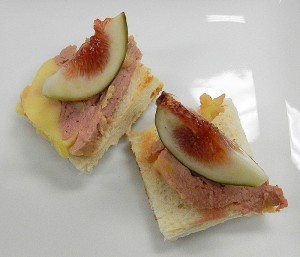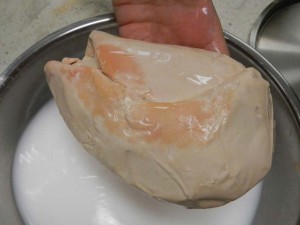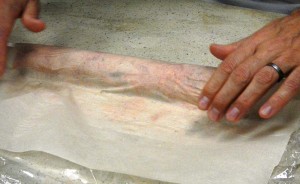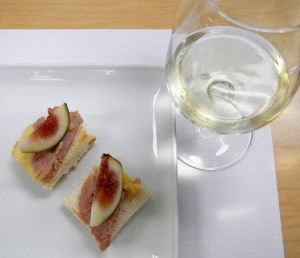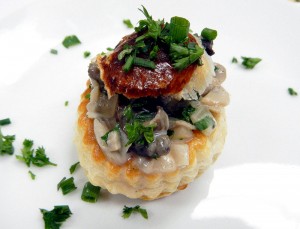In our previous class we started preparing ‘Foie Gras au Naturel‘ for this third class. At $225/kilo, and requiring a very precise SousVide Water Oven to cook it correctly, this fancy duck liver is not something I’m going to be making at home any time soon.
The process, however, was very interesting so here goes:
• The foie gras is covered with a water & milk mixture, and placed in the refrigerator for several hours
• The main membrane as well as any veins are removed.
• The cleaned foie gras is seasoned with salt, pepper and sugar
• The two lobes of the liver are rolled and vacuum-packed
• Once the SousVide water bath reaches precisely 58°C, the packed foie gras is put into it for 50 minutes, then removed and chilled in an ice bath.
• The cooked foie gras is then refrigerated for at least one day before serving
In this class, the chilled foie gras was layered on toasted brioche and topped with a fig wedge. Sinfully good, and exquisite with the wine Chef Eric chose, an Alsace Grand Cru with pure Gewurztraminer flavour. Spicier and less sweet than German-style Gewurztraminer, I gave this wine my maximum 4 stars!
Our other appetizer was ‘Vol-au-Vents‘ (crispy puff pastry shells) filled with ‘Escargots in a Wine and Herb Cream Sauce’, and paired with a Sylvaner. According to Chef Eric, this delicate Alsatian white is perfect to accompany seafood (& snails) but I found it a bit too sour for my taste. The escargot were exquisite though.
For part 2 of this third Alsatian cooking class: https://blogs.ubc.ca/albatz/2012/12/16/food-wine-of-the-alsace-cooking-class-3-part-2/
For the intro to our second class of Alsatian cuisine: https://blogs.ubc.ca/albatz/2012/12/12/ubc-food-wine-of-alsace-class-2-part-1/
For the intro to our first class of Alsatian cuisine:
https://blogs.ubc.ca/albatz/2012/10/19/the-food-wine-of-alsace-ubc-class-1-part-1/

